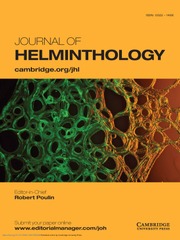No CrossRef data available.
Article contents
A comprehensive analysis of fasciolosis prevalence and risk factors in humans and animals: First report in Algeria
Published online by Cambridge University Press: 14 February 2025
Abstract
This systematic review and meta-analysis examined 27 studies published between 2003 and 2024 to assess the prevalence of Fasciola hepatica infestation in various animal species in Algeria. Diagnostic methods included liver inspection (16 studies), ELISA (7 studies), coproscopy (4 studies), bile microscopy (1 study), and abattoir data analysis (1 study). For humans, coproscopy and immunoelectrophoresis (IEP) were used in one study in Algiers. Among the 1,006,751 animals examined, 15,868 tested positive, resulting in an overall prevalence of 1.57% (CI 1.55–1.59). Prevalence was higher in the northeastern regions of Algeria (El Tarf, Annaba, and Jijel) at 15.95%, compared to other regions (0.9%–2.95%) (p<0.0001). Cattle showed the highest prevalence (3.91%; CI 3.84–3.98) (p<0.001), followed by sheep (0.42%; CI 0.40–0.44) and goats (0.12%; CI 0.10–0.14). Camels had a prevalence rate of 4%. Trend analysis over 20 years indicated a progressive decrease in prevalence, from 13.29% (2004–2009) to 1.79% (2010–2019) and 1.12% (2020–2024) (p<0.0001). The ELISA method was found to be the most sensitive, revealing a prevalence of 16.40% (CI 15.23–17.57) (true adjusted prevalence is 12.38%) (p<0.0001), significantly higher than liver inspection (1.83%), coproscopy (1.04%), and abattoir data analysis (1.10%). Prevalence increased with animal age across all species. This study clearly shows that fasciolosis in Algeria is most prevalent in the northeast region and that cattle are the high-risk group of animals. As a result, control strategies are urgently needed, targeting cattle in particular in northeast Algeria, to prevent and control this disease and thus reduce Fasciola infection.
- Type
- Review Article
- Information
- Copyright
- © The Author(s), 2025. Published by Cambridge University Press


